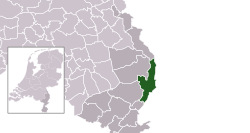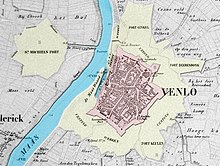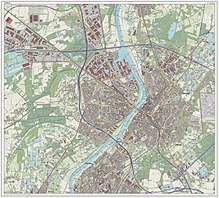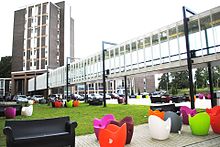A nation that was once starving under the Nazis has transformed itself into a global leader in food production https://bloom.bg/2CW3DSJ
英文影片
荷蘭芬洛🇧🇶 農業創新園區

”The Making of Greenport Venlo” Venlo, The Netherlands ep7

”The Making of Greenport Venlo” Venlo, The Netherlands ep7
Holland is the second largest exporter of agricultural products in the world. Venlo, a city in southeastern Holland, has been one of the largest producers and distribution centers of vegetables, fruits and flowers since the 19th century. To remain vigorous and competitive, the local government built the ‘Greenport’ to help face the challenges of the future. By means of comprehensive land and water transportation, advanced automation equipment, and information systems, they established a logistics and industrial cluster. Farmers are encouraged to engage in innovation and development to attract high-tech agricultural talent and companies. Intelligent technology helps pave the way to an innovative, efficient and sustainable future for traditional agriculture.
劉嵩
Wikipedia
Venlo
| |
|---|---|
City and municipality
| |

Venlo city centre
| |

Location in Limburg
| |
| Coordinates: 51°22′N 6°10′E Coordinates: 51°22′N 6°10′E | |
| Country | |
| Province | |
| Government | |
| • Body | Municipal council |
| • Mayor | Antoin Scholten (VVD) |
| Area | |
| • Total | 128.99 km2 (49.80 sq mi) |
| • Land | 124.96 km2 (48.25 sq mi) |
| • Water | 4.03 km2 (1.56 sq mi) |
| Elevation | 21 m (69 ft) |
| Population
(August 2017)[4]
| |
| • Total | 101,092 |
| • Density | 809/km2 (2,100/sq mi) |
| Demonym(s) | Venloër, Venlonaar, Venloënaar |
| Time zone | UTC+1 (CET) |
| • Summer (DST) | UTC+2 (CEST) |
| Postcode |
5900–5951
|
| Area code | 077 |
| Website | venlo |
Venlo (Dutch: [ˈvɛnloː] ( listen)) is a city and municipality in the southeastern Netherlands, within a couple of miles from the German border. It is situated in the province of Limburg. The municipality of Venlo counted 101,578 inhabitants as of January 2019.[5]
listen)) is a city and municipality in the southeastern Netherlands, within a couple of miles from the German border. It is situated in the province of Limburg. The municipality of Venlo counted 101,578 inhabitants as of January 2019.[5]
Contents
History[edit]
Early history[edit]
Roman and Celtic coins have been found in Venlo; it was speculated to have been the settlement known as Sablones on the Roman road connecting Maastricht with Xanten, but the little evidence there is concerning the location of Sablones speaks against this thought while there is no evidence in support of it. Blerick, on the west bank, was known as Blariacum.
Documents from the 9th century mention Venlo as a trade post; it developed into one of the more important ones in the Meuse-Rhine area, receiving city rights in 1343, and becoming a member of the Hanseatic League in 1375.
Because of its strategic importance, the city of Venlo was besieged several times. The most significant siege was that of 1702, carried on by Menno van Coehoorn. Consequently, Venlo was incorporated into the Generaliteitslanden of the United Provinces at the Treaty of 1713. After the Napoleonic Wars it became part of the United Kingdom of the Netherlands.
World War II[edit]
On 9 November 1939, two British Intelligence Service agents were kidnapped by the Sicherheitsdienst in what became known as the Venlo Incident. The incident was used by the Nazis to link Great Britain to Georg Elser's failed assassination of Hitler at the Bürgerbräukeller the day before and to justify their later invasion of the Netherlands, a neutral country, on 10 May 1940.
Venlo had both a road and a railway bridge over the Maas (River Meuse). The city was severely damaged by bombing raids (13 October – 19 November 1944) on the bridges at the end of the war. Allied forces made 13 attempts to destroy the bridges to cut the German supply lines and block a retreat of the German army across the river. These failed, and it was the retreating German troops who in the end blew up the bridges in an attempt to stop the allied advance. Allied forces liberated Venlo from the east, from inside Germany itself.
About 300 people were killed due to those raids. The raids also cost Venlo a major part of its historical buildings. However, some old buildings, such as the city hall (the 'Stadhuis') and the 'Römer' house, survived the war relatively unscathed.
Before the war, Venlo had an active Jewish community. Most of the Jews were murdered in The Holocaust.
Post-Second World War era[edit]
By the late 1990s, drug-related nuisance had become a problem in the centre of Venlo.[6] National and municipal officials launched the Q-4 Project and Tango initiatives that, amongst other measures, included moving the town's largest coffeeshops[7] to the outskirts, where they continue to do business, while the city centre was freed from disturbances.
In 2001, the municipalities of Belfeld and Tegelen were merged into the municipality of Venlo. Tegelen was originally part of the Duchy of Jülich centuries ago, whereas Venlo has a past in the Duchy of Guelders. On 1 January 2010, the municipality of Arcen en Velden, was merged into the municipality of Venlo.
In 2003 Venlo was awarded the title "Greenest city of Europe". Venlo was the host of Floriade 2012, the world's largest horticultural exhibition.
In 2013, Venlo won the prestigious 'Best City Centre of the Netherlands' award. It amazed the jury by all the investments which have been made in the last couple of years in the Maas Boulevard, the railway station, the tunnel in the centre and the Maas bridge.[8]
Culture[edit]
- Theatre "De Maaspoort"
- Limburg Museum and Art Museum "Museum van Bommel van Dam"
- Venlo Police Museum
- Pop venue Grenswerk (formerly Perron 55)
- Major annual cultural events
- Carnival called "Vastelaovend" in February/March (6 weeks before Easter).
- Summer park festivities called "Zomerparkfeest" in August held in and around the main park of Venlo, a 4 days podium for a broad audience, including live music, film, dance, art etc.















沒有留言:
張貼留言
注意:只有此網誌的成員可以留言。